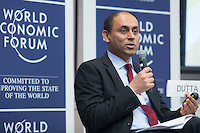Networked Readiness: Much More Than Cell Phone Coverage
Johnson Dean Soumitra Dutta, co-editor of the Global Information Technology Report 2014, with the World Economic Forum and INSEAD, unveiled the 13th annual ranking of nation’s ability to build and benefit from information and communication technologies

Soumitra Dutta, the Anne and Elmer Lindseth Dean and professor of Management at the Samuel Curtis Johnson Graduate School of Management at Cornell University, today unveiled the 2014 edition of a critical report on nations’ networked readiness. The Global Information Technology Report 2014 (GITR) is a collaboration between the World Economic Forum, Johnson at Cornell University, and INSEAD. Dutta, who co-edits the report, spoke at the report launch at the World Economic Forum’s New York City office. The report unveiling was broadcast live on CornellCast and is archived there.
The GITR utilizes a set of measures that result in the Networked Readiness Index (NRI), which provides insights to the capacity of 148 economies to leverage information and communication technologies (ICT) for growth and well-being.
Among the important takeaways of this year’s report is that a digital divide still exists and is very persistent in emerging economies. Some countries seem unable to make progress and gain the benefits of a strong ICT infrastructure, said Benat Bilbao-Osorio, senior economist with the World Economic Forum. Even when countries make strides improving ICT, many lack the skilled workforce necessary to reap the benefits of technology, he said.
China, a large and rapidly developing economy stagnated in the GITR rankings this year, even though it has an enormous number of cell-phone users. Cell phone penetration doesn’t necessarily indicate a high-level of networked readiness for an economy. There is a difference between how much cell phone technology is being used and whether ICT is being integrated across the sprawling nation, in both urban and rural areas.
“The issue with China is similar to that in other emerging markets. It’s not just the number of people who have smart phones, it’s a question of how government, businesses, and organizations are changing their processes to actually benefit from it,” Dutta said. “You can give technology to school children, but if teachers don’t change the way they teach, the benefits of the technology aren’t realized.”
The full Global Information Technology Report 2014 is available online, along with rankings and an interactive map of the 148 countries in the study.
